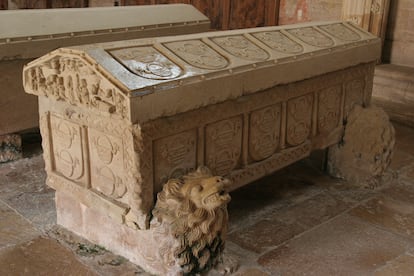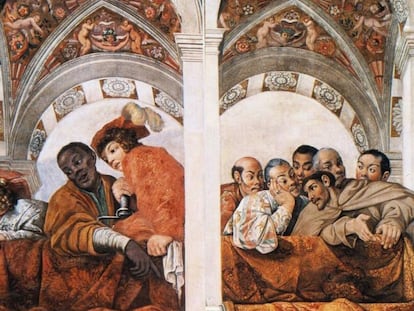The empowered women of the Spanish Middle Ages
Their role was more complex and varied than the popular stereotypes depicting them as nuns, aristocrats or sinners


Queens who influenced the history of their kingdom and female weavers who made the luxurious clothes worn by the grand dames of the era; aristocratic ladies who founded monasteries and powerful abbesses who ruled them; patrons of the arts and illiterate minstrels – the role of women in the Iberian peninsula during the Middle Ages was much more complex and varied than the popular stereotypes that depict them as either nuns, aristocrats or sinners.
A three-day course held last week by the Santa María la Real Foundation in Aguilar de Campoo, in Spain’s Palencia province, brought together experts from half a dozen Spanish universities to establish the true role of women during the period dominated by Romanesque art, roughly covering the 11th, 12th and part of the 13th centuries.
One example put forward was Doña Mencía de Lara, a countess who, after losing her husband, became the abbess of the Palencia monastery of San Andrés de Arroyo, which she herself founded around 1180. Doña Mencía also exercised civil and criminal jurisdiction over 11 villages in the area, explained the course director, Pedro Luis Huerta.
We need to get rid of the idea that they were confined to the home, the convent or the palaceDiana Pelaz, University of Santiago de Compostela
According to Diana Pelaz, from the University of Santiago de Compostela, “women were active in all areas of life, and there were a number of exceptional figures. We need to get rid of the idea that they were confined to the home, the convent or the palace. That’s another of the dark ideas associated with the Middle Ages.”
A French noblewoman named Eleanor of Aquitaine, who was the queen consort of both France and England at various times, also stands out. “Already an octogenarian, she crossed the Pyrenees and traveled to Palencia to decide which one of her granddaughters should be the queen consort of France,” adds Pelaz, insisting that, although it was a patriarchal society driven by a religious mentality, it did not mean that women were entirely oppressed.
“We see them wielding their independence, perhaps more so when they were widowed,” she says. “And there were also those who gave themselves over to religious life without having to adopt a cloistered lifestyle. The lack of definitive regulations typical of the Middle Ages worked in their favor.”
This, she adds, was the case when it came to guilds. A pioneering woman named Velasquita Giráldez founded the tailors’ guild in Oviedo in 1232. “The problems started when they began to regulate – then the women were left out.”
Composers of high-brow music
The supposed silence of women during this period is of particular interest to the medieval expert Josemi Lorenzo Arribas, who says that this perception is owed to subsequent interpretations by historians rather than to the actual state of affairs at the time. “The role of women was a cultural taboo that, thanks to feminism, has now been reconsidered,” he said.
Lorenzo points out that there is evidence of female composers of more classical styles of music as well as troubadours and minstrels, who were no different from the men when it came to their trade. Predominantly nomadic, they would often be from the lower classes and, though sometimes illiterate, would memorize and narrate extensive love stories.

“There were cantoras – who taught Mass songs and also directed their performance in the monasteries. There were endechaderas who sang funeral chants; and soldaderas who sang for pay… You have to take into account that medieval music is almost entirely vocal, as there were hardly any instruments.”
Lorenzo flags up the abbess María González de Agüero, who composed a planctus – a dirge or song of mourning – and who developed her musical skills at the Santa María la Real de las Huelgas monastery in Burgos, around 1300. “I believe her to be the first female Hispanic composer that we know of,” says the researcher.
Again, the establishment of norms – in this case via the polyphony at academic centers – started to shut women out of the picture. But González de Agüero agrees with Pelaz that life wasn’t as dark as is sometimes painted for the women of the period. “They had more freedom then than they did after the [Catholic Church’s] Council of Trent in 1545, for example,” she says. “And during the Baroque period in the 17th century, their situation was far worse.”
The Féminas course also touched on women’s dress in the Middle Ages. Laura Rodríguez Peinado, a professor of art history at Complutense University of Madrid, explained that women’s clothing was very similar to men’s “The tunic or saya was the basic garment, and was worn over a shirt, which was the undergarment,” she said. “The lower classes used fabrics made from wool or hemp and they wore their clothes until they fell apart. And they used poor quality dyes. Meanwhile, the ruling classes had a selection of fine garments, although they did not have a large wardrobe.” These, she says, were made from fine wool and linen, cotton and silk – fabrics with exquisite decoration and bright colors.
Rodríguez Peinado highlighted the fact that most of the clothes of the period were fashioned by women. “Although it was the men that ran the workshops, it was the women who made the outfits, and there were female weavers with their own looms as well as professional embroiderers.”
Eleanor of England, the wife of Alfonso VIII of Castile, bankrolled the Huelgas monastery in Burgos
Noblewomen would also embroider and weave, and they sometimes commissioned pieces to be made. In fact, there are documents indicating that the stole of Sant Narcís inside the Sant Feliú basilica in Girona, was woven and embroidered by an abbess, who also paid for it.
This role of arts patron among the female elite led to the establishment of Cistercian monasteries in the peninsula in the 12th and 13th centuries. Professor María Concepción Cosmen, from the Institute of Medieval Studies at the University of León, mentions up to 15 monasteries in present-day Castile and León paid for by queens, princesses and aristocratic ladies. The most significant case is that of Eleanor of England, the wife of Alfonso VIII of Castile, who bankrolled the Huelgas monastery in Burgos.
Naturally, these powerful women liked to see themselves reflected in what they had paid for. According to Juan Antonio Olañeta, from the University of Barcelona, one of the scenes depicted in the prayer book commissioned by Queen Sancha of León for her consort Fernando I shows a scribe handing the gift to the king while looking reverentially back at the queen. After all, she’d paid for it.
English version by Heather Galloway.
Tu suscripción se está usando en otro dispositivo
¿Quieres añadir otro usuario a tu suscripción?
Si continúas leyendo en este dispositivo, no se podrá leer en el otro.
FlechaTu suscripción se está usando en otro dispositivo y solo puedes acceder a EL PAÍS desde un dispositivo a la vez.
Si quieres compartir tu cuenta, cambia tu suscripción a la modalidad Premium, así podrás añadir otro usuario. Cada uno accederá con su propia cuenta de email, lo que os permitirá personalizar vuestra experiencia en EL PAÍS.
¿Tienes una suscripción de empresa? Accede aquí para contratar más cuentas.
En el caso de no saber quién está usando tu cuenta, te recomendamos cambiar tu contraseña aquí.
Si decides continuar compartiendo tu cuenta, este mensaje se mostrará en tu dispositivo y en el de la otra persona que está usando tu cuenta de forma indefinida, afectando a tu experiencia de lectura. Puedes consultar aquí los términos y condiciones de la suscripción digital.
More information
Últimas noticias
There is as much life left to discover on planet Earth as that which is already known
Dozens presumed dead, around 100 injured in fire at Swiss Alps bar during New Year’s celebration
Is porn for women different from conventional porn? We spoke to those who make it
Cartagena de Indias is sinking: What can the city do to mitigate it?
Most viewed
- Reinhard Genzel, Nobel laureate in physics: ‘One-minute videos will never give you the truth’
- David King, chemist: ‘There are scientists studying how to cool the planet; nobody should stop these experiments from happening’
- Oona Chaplin: ‘I told James Cameron that I was living in a treehouse and starting a permaculture project with a friend’
- Sinaloa Cartel war is taking its toll on Los Chapitos
- The Interoceanic Train, the Mexican alternative to the Panama Canal









































